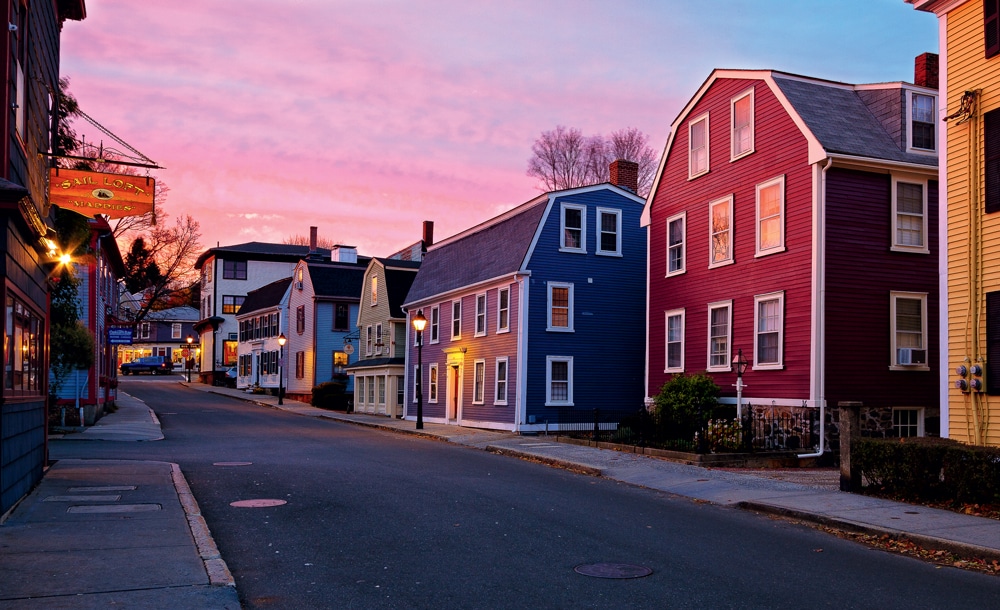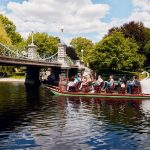Best 5 Places to See Historic Homes in New England
If you love exploring New England historic neighborhoods for pleasure, inspiration, or to enhance your Instagram feed, these are the best spots to stroll.

Coffee By Design | Portland, Maine
Photo Credit : Katherine KeenanOwning a piece of New England’s architectural past may be out of reach, but admiring resilient craftsmanship from the street, well, that’s free. If you love exploring New England historic neighborhoods for pleasure, inspiration, or to enhance your Instagram feed, these are the best spots to stroll.

Photo Credit : Eyal Oren
Best 5 Places to See Historic Homes in New England
Newport, Rhode Island
Known for its flashy Gilded Age mansions, Newport also has more than 400 homes and religious and civic buildings that pre-date 1799. Some, such as the 1697 Wanton-Lyman-Hazard House, are now museums, but many others remain the center of everyday life, including dozens of finely restored Colonial-era residences in the waterfront neighborhood known as the Point. Its warped brick sidewalks aren’t trodden by as many tourists as the mansion-lined Cliff Walk, but here is your rare chance to see what a wooden city looked like in a prosperous colonial seaport.
Explore: Sample the walking tours offered by the Newport Historical Society. newporthistorytours.org
Marblehead, Massachusetts
“The houses are old,” George Washington wrote by way of explaining why he took a four-mile detour to visit this seaside town while on a 1789 trip. With America’s largest collection of pre–Revolutionary War structures (200-plus) and hundreds more built before 1830, this peninsular town of narrow streets and tiny-plot gardens seems to have been gently treated by time’s passage. It is, however, the harshness of wars, storms, and fishing fleet losses that slowed Marblehead’s development and thereby helped preserve such landmarks as the virtually intact Georgian-style Jeremiah Lee Mansion, completed in 1768. Walk along Franklin, Washington, and Hooper streets, and you’ll feel as though you’ve completed a course in Early American architecture.
Explore: Take a compelling, architecture-focused walking tour with historian Judy Anderson. marbleheadtours.com
Portsmouth, New Hampshire
With their embellished doorways and authentic paint colors—mustard, dusty blues, cinnamon red, and earth tones—the well-preserved clapboard colonials in Portsmouth’s South End have irresistible allure for artists and photographers. Strawbery Banke Museum is home to 32 historic structures, dating back as far as 1695, that illustrate this neighborhood’s 300-year evolution; more vintage homes can be seen lining antique lanes such as Mechanic Street. Nearby are the Portsmouth Athenaeum and other brick beauties from the 19th century, the Federal mansions of Haymarket Square and Middle Street, Victorian showpieces like the Benjamin Franklin Webster House, and even the postwar Atlantic Heights neighborhood of Colonial Revival cottages built to house shipyard workers—all worth finding, photographing, and admiring.
Explore: Join in on one of Portsmouth Historical Society’s preservation-themed walking tours. portsmouthhistory.org
Wethersfield, Connecticut
With so much architectural charm centered on the three historic homes of the Webb-Deane-Stevens Museum, casual visitors may think that’s the sole reason to visit Old Wethersfield. On a brick sidewalk stroll, though, you’ll see many fine homes from the colonial and Federal eras, with Victorians and America’s oldest seed company, Comstock Ferre, salted in. Hop in your car or on a bike, and find vintage structures that stir the imagination: an imposing warehouse in Cove Park, last of seven built here c. 1690; the chrome-yellow Richard Deming House, a rare surviving average-family home built c. 1710; the Buttolph-Williams House, another early gem and the setting for The Witch of Blackbird Pond. In all, Connecticut’s largest historic district has 150-plus structures whose stories begin before 1850. Explore: Pick up a self-guided Wethersfield Heritage Walk brochure at Webb-Deane-Stevens. webb-deane-stevens.org
Woodstock, Vermont
New England builders didn’t have HGTV or the DIY Network in the early 19th century, but they did have Asher Benjamin’s design-filled little book, The Country Builder’s Assistant, which popularized Federal-style architecture. Woodstock bears the beautiful imprint of this era, when homes constructed around the village green and along adjoining Elm Street reflected the town’s rising stature as a hub of manufacturing, business, and county government. The fun in walking around here is scanning the proliferation of Early American structures for details of later architectural evolution, from the tall windows, quoins, and overhanging eaves of the Italianate style to an add-on Queen Anne turret.
Explore: Delve into the Woodstock History Center’s free I Spy…Architecture! guide, available online or at the Town Crier bulletin board on Elm Street. woodstockhistorycenter.org








Great list. Without criticizing at all – these sorts of exercises are just fun and should generate debate – I would included Deerfield, MA on a list of places to visit. The historic section of Deerfield may be smaller than some of these, but it’s hard to beat it for the history of frontier living it offers along with its architecture.
Absolutely! Deerfield is a must-see.
Great article and list. I think Litchfield CT should have honorable mention as well…
Don’t forget Nantucket. The whole island is a historic district.
Grew up in marblehead — it is a wonderful town
And then there’s Salem, MA!
Yes Salem Mass for sure…..my hometown!
While my first love is colonial homes, any list of historic homes should also include historic Victorian homes and historic mid century modern homes. For Victorian homes it is tough to beat Oak Bluffs. Laurel Park in Northampton, MA is a smaller but similar old Methodist campground. One street, right out of Mary Poppins is surprisingly in Holyoke, MA where there are many Victorian houses, some of them once great Fairfield Street is in a class of its own. The individual houses are not mansions like in Newport, but lower upper class or upper middle class homes of the day. The street is almost untouched by time with a small park down the middle of the road. https://www.google.com/search?q=fairfield+avenue+holyoke+ma&source=lnms&tbm=isch&sa=X&ved=2ahUKEwjLpfrRzOnvAhWSVc0KHTIyARoQ_AUoA3oECAEQBQ&biw=1365&bih=629&dpr=3. There are so many town greens in New England that are replete with houses of the vintage of the town, that it could fill an entire issue just listing them. Boston’s Beacon Hill, especially Louisburg Square, and Bay Village have to be mentioned when considering places to view historic houses. Of course there is all of Back Bay for Nineteenth century houses. There are a few Frank Lloyd Wright houses in New England, including two in Manchester, New Hampshire owned by the Currier Museum.https://currier.org/frank-lloyd-wright/
I could read Yankee for hours a day! Great to read the places I’ve been. Hope to visit new ones I read in the publication! Thanks
Receive and wouldn’t miss Yankee mag. and thou live in Greenwood, SC in a CCRC community, am from Cambridge, Mass. Ellen de Guzman
You left out Concord, MA
There is no other place on earth as beautiful and serene as the New England states…valleys, mountain ranges and coastlines….and history at its best.
What about Cambridge, Ma near Harvard Square which includes Longfellow’s house and all the houses on Tory Road/Brattle St, not to mention Harvard Yard with all those wonderful brick buildings Bd. Lose to the wonderful Charles River. Did I mention I grew up there ten minutes from Harvard Square and minutes from the Radcliffe forms.
Old Deerfield, MA has gorgeous colonial homes on a beautiful and quaint street.
Plymouth Sturbridge also make the list
And what about Benefit St. on Providence, RI’s East Side?
Main St near Hingham Sq.
I sure hope I get to go to some of these town and of love Yankee Magazine Thank You
Duxbury, Massachusetts. Beautiful coastal town.